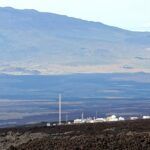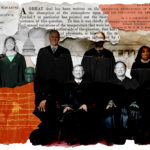Permitting reform is back from the dead. Will lawmakers sacrifice America’s public lands to the fossil fuel industry?
By Dustin Mulvaney | September 12, 2024
 Illustration by Erik English; original photos: Illustrated Times map of the United States of North America, public domain; Solar One power plant in Barstow, Mojave Desert, California, NREL.
Illustration by Erik English; original photos: Illustrated Times map of the United States of North America, public domain; Solar One power plant in Barstow, Mojave Desert, California, NREL.
Like a zombie returned from the dead, permitting reform is back on the Congressional agenda. The Energy Permitting Reform Act of 2024, a bill recast out of the Senate Energy and Natural Resources Committee and championed by Senators Joe Manchin (I-WV) and John Barrasso (R-ID), could be headed to the Senate floor for a vote soon. It contains provisions for everything from undoing the pause on building new liquified natural gas facilities, to letting mining companies dump waste on public lands, to promises to expedite the siting process for electricity transmission lines and fossil fuel infrastructure. In typical bipartisan fashion for energy legislation, western public lands are for sale to energy and mining industries. Oil and gas producers will get access to more onshore and offshore energy, force the approval of new liquified natural gas facilities along the Gulf of Mexico to export, and reverse an important court decision and allow mining companies to treat public lands like a hazardous waste dump.
More than 360 environmental organizations sent a letter to the committee chair asking the vote be denied passage, calling it “the latest Dirty Permitting Deal.” The letter cites the impacts from new fossil fuel infrastructure that will be enabled by the legislation, which one estimate found would lock-in carbon burning infrastructures that would emit greenhouse gas emissions equivalent to 165 coal-fired power plants over their lives.
While most environmental organizations oppose this latest dirty deal, some climate action hopefuls point to the upside in the bill, which suggests expanded renewable energy and electricity transmission lines to bring it to where it is needed. Among other things, the legislation expands the mandate for the Department of the Interior to make available enough land to build 50 gigawatts of renewable energy projects including solar, wind, and geothermal by 2030:
“Subsection (a) sets a new goal for the secretaries of the Interior and Agriculture to authorize 50 gigawatts of renewable energy on federal land by 2030, and directs periodic revision of the national goal for renewable energy production on federal land.”
Many will see these 50 gigawatts in the proposed policy and assume this is additional renewable energy. Great news! We need all the renewable energy we can get right?
Unfortunately, that’s now how this works. The 50 gigawatts will be for renewable energy projects that utilities and other power purchasers have already committed to build in order to satisfy their obligations under state renewable energy portfolio laws. Committing to make public lands available to renewable energy developers merely guarantees that these projects will result in land use change and ecological impacts. In carbon offset-speak, these renewable projects are not “additional.” Absent this policy to build solar on public lands, these 50 gigawatts would have to be built elsewhere. Across the American west most solar projects are built on water-restricted, salt-contaminated, or marginal farmland or other previously degraded landscapes. Instead, the federal lands commitment directs projects towards greenfield development on open space with cultural resources and wildlife habitat, while it creates cheaper projects for utilities, community choice aggregators, and other buyers of renewable energy who must meet preexisting obligations and regulations.
Supporters of developing solar on public lands should notice they get nothing in return from this policy; it just formalizes existing activities. In May, the Interior Secretary announced 20 gigawatts of renewables have already been permitted, and according to their data there will be 25 gigawatts by the end of 2024, meeting their target early; and over 35 gigawatts by the end of 2025 if everything in the various stages of planning and review right now are built. The 50 gigawatts enshrined in this bill will be hit long before 2030 anyways. The western solar plan, which governs solar development on public lands, just opened 31 million acres to solar development at the end of August. Based on a National Renewable Energy Laboratory analysis, the western solar plan already assumes that 93 gigawatts will be built on public lands by 2035, even without the edict spelled out in the proposed permitting bill.
The bill also contains a provision that affirms a Bureau of Land Management policy required in the Inflation Reduction Act that ties renewable energy development on public lands to oil and gas development; it requires the Secretary of the Department of the Interior, the agency that oversees the bureau, to hold oil and gas lease sales within a year of offering a right-of-way for solar energy development. As the draft language in the Energy Permitting Reform Act of 2024 states:
“Subsection (d) clarifies that this section does not modify existing requirements for the Secretary of the Interior to conduct a minimum amount of onshore oil and gas lease sales in certain years before issuing rights-of-way for renewable energy projects in the subsequent year.”
The “all of the above” energy abundance strategy, which marries fossil fuel development on public lands to renewable energy into perpetuity, is a recipe for undermining conservation and climate goals at the same time. Energy abundance should mean more clean energy infrastructure and affordable green housing, as well as clean air, cleaner water, spaces for people to access nature, and ecosystems conserved from energy sprawl. This Faustian bargain guarantees continued exposure to risks from fossil fuels, with few tangible gains to renewable energy deployment. It is a poorly negotiated giveaway to fossil fuel industries.
It should be no wonder that public lands handouts are at the center of repeated efforts to reform the National Environmental Policy Act and eliminate the green “red tape” believed to be slowing renewables, despite evidence that it is not. Congress and energy developers see public lands as only valuable for disposal; researchers and practitioners in the decarbonization space see land as only useful for renewable energy development, and environmental review as a barrier to development. The widespread prevalence of these views will result in weaker environmental laws to oppose fossil fuels, more public lands for mining and energy, and less land and habitat for conservation and climate adaptation.
Many of the proponents of the Manchin-Barrasso legislation point specifically to benefits to planning for new transmission lines, which helps renewables integration. But this proposal for permitting reform does not do anything to overcome the biggest hurdles to building new interregional transmission lines, like who pays for it and how to overcome utility’s aversion to competition with neighboring utilities. Instead, it makes, at best, minor improvements by requiring utilities plan for more transmission, and recasts policy tools that the federal government largely already has, like expediting permitting timelines to build projects faster, calling them new. In fact, the Rocky Mountain Institute’s modeling also reported by Third Way is the only one to show any greenhouse gas reductions associated with the proposed permitting reform law, but only because they erroneously assume the law is the reason that all future transmission is built. This ignores years of incremental policy incentives to facilitate transmission build out such as the recently implemented Federal Energy Regulatory Commission Order 1920, and grossly overestimates the greenhouse gas benefits from permitting reform.
Fighting the specter of permitting reform is never-ending, especially when its benefactors—utilities, and the oil and gas industry—have so much to profit. Accelerating the energy transition to renewables should not be contingent on the continued dominance and expansion of fossil fuels, nor should it undermine the very environmental laws that have helped clean our water and air under the guise that it somehow allows for more renewable energy development. Permitting reform’s return from the dead seems less about cutting red tape and building renewable energy than satiating the energy industry’s bottomless appetite for America’s public lands.
Read more: Laura Kuhl and Jamie Shinn on the Mountain Valley Pipeline, permitting reform, and energy justice.
Together, we make the world safer.
The Bulletin elevates expert voices above the noise. But as an independent nonprofit organization, our operations depend on the support of readers like you. Help us continue to deliver quality journalism that holds leaders accountable. Your support of our work at any level is important. In return, we promise our coverage will be understandable, influential, vigilant, solution-oriented, and fair-minded. Together we can make a difference.
Keywords: Joe Manchin, energy transition, fossil fuels, permitting reform package, public lands, renewable energy, solar
Topics: Climate Change
















Thanks for your articulate, concise and complete article! I had no idea about the negative aspects of this bill, and looking at the documentation you have provided, I’ve learned a fair amount about it.
Good analysis and commentary. Leaving GHGs and other environmental costs out of equations for assessing the benefits of renewable generation and expansion is both dishonest and fails to harness the advantages of capitalist competition. If we (i.e., the US) insist on “all of the above” answers to energy policy questions (without reducing demand) we will continue to fail in meeting our emissions goals, thereby condemning our grandkids to lives dominated by climate change consequences.